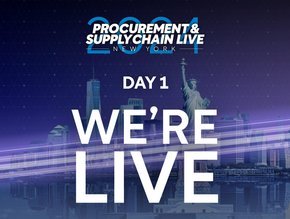Ivalua's Alex Saric on all-in-one Procurement Platforms

Ivalua enables hundreds of private and public sector organisations across the globe – from IKEA, Honeywell and Rolls-Royce to seven different US states – to simplify procurement by effectively managing spend and suppliers in an increasingly complicated world.
With Ivalua’s unified, cloud-based, AI-powered source-to-pay (S2P) platform, customers can improve profitability, drive innovation, improve ESG performance and reduce risk across their supply chain.
Ultimately, the business aims to empower procurement teams with more automation, greater supplier transparency and the ability to collaborate efficiently with suppliers.
Responsible for the company brand and demand generation on a global scale is Alex Saric, Chief Marketing Officer. He manages around fifty people, including regional field marketing, global product marketing, communications, demand generation and customer marketing teams.
Here, Supply Chain Digital sits down with Alex to discuss procurement's shift towards all-in-one platforms and how other industries can follow suit.
Tell us about your career – what led to you joining Ivalua?
I’ve spent the bulk of my career in various product and marketing leadership roles at spend management technology providers – first as a founding member of Zeborg, which was acquired by Emptoris. I then had a long stretch at Ariba, building and leading its spend analysis solution and then leading international marketing.
After Ariba was acquired by SAP, I was eager to get back to a smaller company where there was a stronger connection to customers again. That ultimately led me to Ivalua. I knew some of the team, as well as a few customers, and knew they had a strong product, a customer-centric culture and a focus on doing what’s right for their customers above all else.
I’ve been CMO at Ivalua for almost seven years and I'm happy to say I know I made the right choice.
What's attracting today's procurement leaders to all-in-one platforms?
Three key factors are driving procurement towards managing all spend and suppliers in a single S2P platform.
The first is the need for greater transparency into suppliers. The procurement industry is being asked to address more, and often competing, objectives such as sustainability and cost, while facing growing uncertainty. To be able to make optimal and quick decisions in areas such as sustainability, risk, cost and performance, leaders need a broad set of information, all available at their fingertips. Disparate solutions create data silos, reducing both access to and quality of data. Unified platforms provide a single source of truth, with all information available when and where it's needed.
The second factor is efficiency. As procurement’s maturity has increased and work levels increase faster than resources, teams need to maximise efficiency. A unified platform maximises automation, with information and processes seamlessly flowing from one step of the process to another. Disparate, best-of-breed approaches limit the efficiency gains possible due to the gaps that exist between each step of the process.
Third, procurement increasingly needs to collaborate with more stakeholders, from suppliers to other internal departments. Since collaboration rarely starts and stops at one step of the procurement process, unified platforms can far better support collaboration, embedding those capabilities where users and suppliers are already working.
With a unified platform, organisations are improving efficiency, enabling faster and more informed decision-making, and fostering effective collaboration and innovation among stakeholders and suppliers.

How are procurement leaders staying ahead of the curve when it comes to SaaS buying trends?
Procurement leaders are increasingly purchasing flexible, all-in-one SaaS platforms with embedded generative AI capabilities, rather than a best-of-breed approach favoured in many industries. Such platforms allow organisations to adapt their technology to new data or process requirements and quickly roll-out innovative Gen AI use cases relevant to their business. This is enabling procurement to build agility for rapidly-evolving business objectives and demands.
By ensuring Gen AI is embedded in their S2P technology, procurement is making it simpler and safer for their teams to leverage this innovative technology. This positions them well to benefit from the expanding capabilities and benefits of AI.
Lastly, they are taking a unified platform approach. Even when not deploying a full platform at once, they are purchasing platforms that provide the extensibility to activate more capabilities as needed over time. This ensures they don't constrain transparency or automation and have to switch technology in the future.
What can other industries learn from procurement leaders in this space?
Procurement has a long history of trying different technology approaches and is now shifting towards more flexible, unified platforms having seen the problems and limitations created by best-of-breed or more rigid technology strategies. Others should learn from procurement and ensure they consider the long-term implications of technology decisions together with the immediate benefits.
There are a couple key lessons to heed. First, it's important to assess technology based on both today’s requirements and the flexibility to support unknown requirements in the future. Many procurement teams have found the multi-tenant solutions they purchased couldn't adapt to new data requirements or processes and hindered agility. Today’s rapidly-evolving business and regulatory environments mandate organisational and technological agility. Organisations need the ability to adapt technology without being dependent on the vendor’s roadmap.
Second, other industries should benefit from procurement’s learning on how to assess platforms. Disparate solutions limit transparency and automation, but some so-called ‘unified platforms’ are not much better. Many position themselves as being truly unified, but they are actually collections of disparate solutions built in siloes or via acquisitions. When choosing a software provider, to truly reap the benefits organisations must ensure their chosen platform is built upon a unified data model to ensure data is high quality and accessible. Ideally, it should be built on a single code base to ensure maximum automation.
******
Check out the latest edition of Supply Chain Magazine and sign up to our global conference series – Procurement and SupplyChain LIVE 2024.
******
Supply Chain Digital is a BizClik brand.
- Procurement & Supply Chain LIVE New York 2024: Day Two RecapDigital Supply Chain
- Submissions Closed: Global Procurement & Supply Chain AwardsDigital Supply Chain
- Sustainability Shines Through on P&SC LIVE New York Day OneSustainability
- Celebrating International Supply Chain Professionals DayOperations






